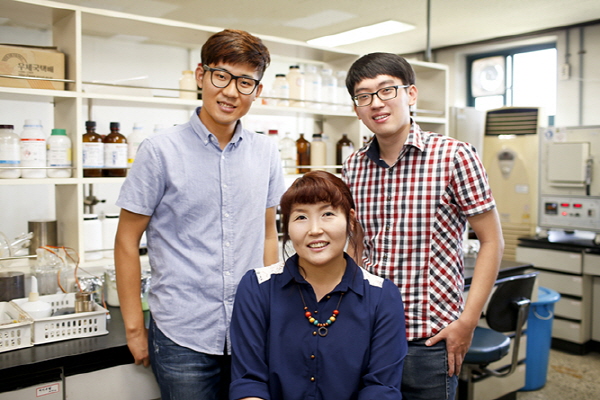Seniors Kim Gang-min and Lim Young-hwan publishes their own papers in SCI international academic journals.
Professor Kang Mi-sook's research lab won 12 awards at domestic and foreign academic societies in 2013 to be recognized for their research abilities.
[August 13, 2014]
YU undergraduates have made news by publishing their studies in SCI-grade international academic journals one after the other. They are Kim Gang-min (24) and Lim Young-hwan (24), who are seniors in the Department of Chemistry.
Kim Gang-min published his second study in SCI-grade international academic journals this year alone. His two papers were on technologies to produce hydrogen, which are next-generation energy sources, in an environmentally-friendly manner. Kim has been focusing on research to develop visible ray sensitive catalysts that can be applied in optical electro-chemical systems to decompose water to make hydrogen using sunlight.
In his paper, Kim produced various sulfide catalysts that respond to visible rays to evaluate their performance. In result, he found that compared to metal oxide semiconductors, which are the existing infrared ray reacting catalyst, hydrogen output increased more. Also, when combining the two metal oxide crystals together, it was confirmed that better hydrogen production efficiency was achieved.
Kim's paper was published in the SCI international academic journal <International Journal of Photoenergy, impact factor (IF) 2.663>, which is in the top 12.5% in the July 2014 issue, and is scheduled to be published in the December 2014 issue of the <Journal of Nanoscience and Nanotechnology, IF 1.149>.
Meanwhile, Lim Young-hwan published his papers on nano-material synthesis that can be applied in the development of next-generation energy sources in SCI international academic journals. Lim has continued research on developing materials of various performances in addition to those existing by adjusting the form or structure of materials.
Lim said, "Titanium dioxide is the representative material of photocatalysts that acts as catalysts by receiving light. It requires large light energy to fulfill its role as a catalyst. Thus, this study was conducted to overcome such weakness."
Based on the fact that copper sulfide can act as a catalyst with less energy than titanium dioxide, Lim carried out the study and found that by synthesizing nano-particles that use copper sulfide as the nucleus and titanium dioxide as the shell, catalyst performance was enhanced.
Furthermore, Lim conducted follow-up research to supplement the weakness of sulfides that are weak against oxygen, vapor and heat to develop more stable and efficient catalysts. Lim said, "In the course of making copper sulfide the nucleus and titanium dioxide the shell, I added ethylene glycol and this made is possible to continuously maintain catalyst performance more stable than existing copper sulfide."
Lim's study was published in the International Journal of Photoenergy in December 2013 when he was a junior and his follow-up study is scheduled to be carried in the September 2014 issue of <Powder Technology, IF 2.024>.
The two students said, "The studies are still in its basic research stages so there are difficulties in using it for practical uses, but by developing photocatalysts that can help with improving water quality by breaking down organic matter through more research, it will help improve environmental issues." He also added, "I would like to go on to graduate school and conduct research on various materials related to energy conversion that can be used in everyday life."
Meanwhile, the Department of Chemistry Inorganic Nano Material Research Lab (advisor Kang Mi-sook), which the two students are members of, published 5 SCI grade papers in 2014 alone. They also won the best poster award in 'Nano Korea 2013' and best poster award in the 'International Symposium on Green Manufacturing and Applications ISGMA 2013)', thus receiving a total of 12 awards by undergraduate and graduate students from various academic societies held in both Korea and abroad to be recognized for their research capacities. In particular, the 'Graduate School Catalyst Research Award' that is given to graduate school students with the best research performance annually by the Korean Institute of Chemical Engineers was won by this lab for two straight years in 2013 (Lee Joon-sung, master's) and in 2014 (Lee Ga-young, master's).










